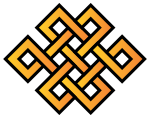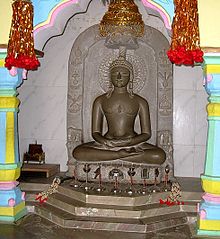Ashtamangala

Ashtamangala: first row (left to right): parasol, pair of golden fish, conch; second row: treasure vase, lotus; Last row: infinite knot, victory banner and wheel.
The Ashtamangala are a sacred suite of Eight Auspicious Signs endemic to a number of Indian religions such as Hinduism, Jainism, and Buddhism. The symbols or "symbolic attributes" (Tibetan: .mw-parser-output .uchenfont-family:"Qomolangma-Dunhuang","Qomolangma-Uchen Sarchen","Qomolangma-Uchen Sarchung","Qomolangma-Uchen Suring","Qomolangma-Uchen Sutung","Qomolangma-Title","Qomolangma-Subtitle","Qomolangma-Woodblock","DDC Uchen","DDC Rinzin",Kailash,"BabelStone Tibetan",Jomolhari,"TCRC Youtso Unicode","Tibetan Machine Uni",Wangdi29,"Noto Sans Tibetan","Microsoft Himalaya".mw-parser-output .umefont-family:"Qomolangma-Betsu","Qomolangma-Chuyig","Qomolangma-Drutsa","Qomolangma-Edict","Qomolangma-Tsumachu","Qomolangma-Tsuring","Qomolangma-Tsutong","TibetanSambhotaYigchung","TibetanTsugRing","TibetanYigchung"ཕྱག་མཚན་, THL: chaktsen) are yidam and teaching tools. Not only do these attributes (or energetic signatures) point to qualities of enlightened mindstream, but they are the investiture that ornaments these enlightened "qualities" (Sanskrit: guṇa; Tibetan: ཡོན་ཏན་, THL: yönten). Many cultural enumerations and variations of the Ashtamangala are extant.
.mw-parser-output .templatequoteoverflow:hidden;margin:1em 0;padding:0 40px.mw-parser-output .templatequote .templatequoteciteline-height:1.5em;text-align:left;padding-left:1.6em;margin-top:0
Groupings of eight auspicious symbols were originally used in India at ceremonies such as an investiture or coronation of a king. An early grouping of symbols included: throne, swastika, handprint, hooked knot, vase of jewels, water libation flask, pair of fishes, lidded bowl. In Buddhism, these eight symbols of good fortune represent the offerings made by the gods to Shakyamuni Buddha immediately after he gained enlightenment.[1]
Contents
1 In Buddhism
1.1 Conch
1.2 Endless knot
1.3 Fish
1.4 Lotus
1.5 Parasol
1.6 Vase
1.7 Dharmachakra
1.8 Victory Banner
2 Sequences of symbols
3 Hindu symbols
4 Jain symbols
5 See also
6 Notes
7 References
8 External links
In Buddhism
Tibetan Buddhists make use of a particular set of eight auspicious symbols, ashtamangala, in household and public art. Some common interpretations are given along with each symbol although different teachers may give different interpretations:
Conch

Śaṅkha
The right-turning white conch shell (Sanskrit: śaṅkha; Tibetan: དུང་དཀར་གཡས་འཁྱིལ་, THL: dungkar yénkhyil) represents the beautiful, deep, melodious, interpenetrating and pervasive sound of the dharma, which awakens disciples from the deep slumber of ignorance and urges them to accomplish their own welfare and the welfare of others.
The conch shell is thought to have been the original horn-trumpet; ancient Indian mythical epics relate heroes carrying conch shells. The Indian god Vishnu is also described as having a conch shell as one of his main emblems; his shell bore the name Panchajanya meaning "having control over the five classes of beings".[1]
In Hinduism, the conch is an attribute of Vishnu along with the Sudarshana Chakra. Vaishnavism holds that Gautama Buddha is an avatar of Vishnu.[citation needed]
Endless knot

Endless knot
The endless knot (Sanskrit: śrīvatsa; Tibetan: དཔལ་བེའུ་, THL: pelbeu)[2] denotes "the auspicious mark represented by a curled noose emblematic of love".[3] It is a symbol of the ultimate unity of everything.[4] Moreover, it represents the intertwining of wisdom and compassion, the mutual dependence of religious doctrine and secular affairs, the union of wisdom and method, the inseparability of śūnyatā "emptiness" and pratītyasamutpāda "interdependent origination", and the union of wisdom and compassion in enlightenment (see namkha). This knot, net or web metaphor also conveys the Buddhist teaching of interpenetration.[citation needed]
Fish

Pair of golden fish
The two golden fish (Sanskrit: gaurmatsya; Tibetan: གསེར་ཉ་, THL: sernya[5]) symbolise the auspiciousness of all sentient beings in a state of fearlessness without danger of drowning in saṃsāra.[citation needed] The two golden fishes are linked with the Ganges and Yamuna nadi, prana and carp:
The two fishes originally represented the two main sacred rivers of India - the Ganges and Yamuna. These rivers are associated with the lunar and solar channels, which originate in the nostrils and carry the alternating rhythms of breath or prana. They have religious significance in Hindu, Jain and Buddhist traditions but also in Christianity (the sign of the fish, the feeding of the five thousand). In Buddhism, the fish symbolize happiness as they have complete freedom of movement in the water. They represent fertility and abundance. Often drawn in the form of carp, which are regarded in the Orient as sacred on account of their elegant beauty, size, and life-span.[1]
In Islam the (alive) fish has a significant role in the meeting between Moses and Khidr.
Lotus

The lotus flower, or padma.
The lotus flower (Sanskrit: padma; Tibetan: པད་མ་, THL: péma), represent the primordial purity of body, speech, and mind, floating above the muddy waters of attachment and desire. The lotus symbolizes purity and renunciation. Although the lotus has its roots in the mud at the bottom of a pond, its flower lies immaculate above the water. The Buddhist lotus bloom has 4, 8, 16, 24, 32, 64, 100, or 1,000 petals. The same figures can refer to the body's 'internal lotuses', that is to say, its energy centres (chakra).[6][7]
Parasol

Jewelled parasol
The jewelled parasol (Sanskrit: chatraratna; Tibetan: རིན་ཆེན་གདུགས་, THL: rinchenduk[3]), which is similar in ritual function to the baldachin or canopy: represents the protection of beings from harmful forces and illness. It represents the canopy or firmament of the sky and therefore the expansiveness and unfolding of space and the element æther. It represents the expansiveness, unfolding and protective quality of the sahasrara: all take refuge in the dharma under the auspiciousness of the parasol.
Vase

Treasure vase
The treasure vase (Tibetan: གཏེར་ཆེན་པོའི་བུམ་པ་, THL: terchenpo'i bumpa) represents health, longevity, wealth, prosperity, wisdom and the phenomenon of space. The treasure vase, or pot, symbolizes the Buddha's infinite quality of teaching the dharma: no matter how many teachings he shared, the treasure never lessened.[8]
The iconography representation of the treasure vase is often very similar to the kumbha, one of the few possessions permitted a bhikkhu or bhikkhuni in Theravada Buddhism. The wisdom urn or treasure vase is used in many empowerment (Vajrayana) and initiations.[citation needed]
Dharmachakra

The dharmachakra
The dharmachakra or "Wheel of the Law" (Sanskrit; Tibetan: ཆོས་ཀྱི་འཁོར་ལོ་, THL: chö kyi khorlo) represents Gautama Buddha and the Dharma teaching. This symbol is commonly used by Tibetan Buddhists, where it sometimes also includes an inner wheel of the Gankyil (Tibetan). Nepalese Buddhists don't use the Wheel of Law in the eight auspicious symbols.
Instead of the dharmachakra, a fly-whisk may be used as one of the ashtamangala to symbolize Tantric manifestations. It is made of a yak's tail attached to a silver staff, and used in ritual recitation and during fanning the deities in pujas. Prayer wheels take the form of a dharmachakra guise. The Sudarshana Chakra is a Hindu wheel-symbol.
Victory Banner

Dhvaja
The dhvaja (Sanskrit; Tibetan: རྒྱལ་མཚན་, THL: gyeltsen) "banner, flag" was a military standard of ancient Indian warfare. The symbol represents the Buddha's victory over the four māras, or hindrances in the path of enlightenment. These hindrances are pride, desire, disturbing emotions, and the fear of death. Within the Tibetan tradition, a list of eleven different forms of the victory banner is given to represent eleven specific methods for overcoming defilement. Many variations of the dhvaja's design can be seen on the roofs of Tibetan monasteries to symbolise the Buddha's victory over four māras. Banners are placed at the four corners of monastery and temple roofs. The cylindrical banners placed on monastery roofs are often made of beaten copper.[9]
Sequences of symbols
Different traditions order the eight symbols differently.
Here is the sequential order of the Eight Auspicious Symbols of Nepali Buddhism:
- Endless knot
- Lotus flower
- Dhvaja
- Dharmachakra (fly-whisk in Nepali Buddhism)
- Bumpa
- Golden Fish
- Parasol
- Conch
The sequential order for Chinese Buddhism was defined[10] in the Qing dynasty as:
- Dharmachakra
- Conch
- Dhvaja
- Parasol
- Lotus flower
- Bumpa
- Golden Fish
- Endless knot
Hindu symbols
In Indian and Hindu tradition,[11] the Ashtamangala may be used during certain occasions including: pujas, weddings (of Hindus), and coronations. The ashtamangala finds wide mention in the texts associated with Hinduism, Buddhism, and Jainism. They have been depicted in decorative motifs and cultural artifacts.
- The Hindu tradition lists them as:
lion called raja
bull called vrishaba
serpent called naga
pitcher called kalasa
necklace called vijayanti
kettle called bher
fan called vyajana
lamp called deepa[12]
- The Hindu tradition lists them as:
- fly-whisk
- full vase
- mirror
- elephant goad
- drum
- lamp
- flag
- a pair of fish.
- The list also differs depending on the place, region, and the social groups.
Jain symbols

Adinath image with Ashtamangala placed in front of it, according to Digambara tradition

Ashtamangala, according to Svetambara tradition, on Jain manuscript cover, LACMA M.72.53.22
(from left) : Swastika, Vardhmanaka (food vessel), Pair of fish, Kalasha (pot), Bhadrasana (seat), Srivatsa, Nandavarta, Darpan (mirror)
In Jainism too, the Ashtamangala are a set of eight auspicious symbols. There is some variation among different traditions concerning the eight symbols.[13]
In the Digambara tradition, the eight symbols are:
- Parasol
- Dhvaja
- Kalasha
- Fly-whisk
- Mirror
- Chair
- Hand fan
- Vessel
In the Śvētāmbara tradition, the eight symbols are:
- Swastika
- Srivatsa
- Nandavarta
- Vardhmanaka (food vessel)
- Bhadrasana (seat)
Kalasha (pot)- Darpan (mirror)
- Pair of fish
See also
- Dzi bead
Eight Treasures (Chinese equivalent)- Iconography
- Mani stone
- Sandpainting
Notes
^ abc Source: [1] (accessed: January 18, 2008) Archived 13 January 2008 at the Wayback Machine
^ Source: Dpal be'u
^ ab Sarat Chandra Das (1902). Tibetan-English Dictionary with Sanskrit Synonyms. Calcutta, India: mainly used in buddhismBengal Secretariat Book Depot, p.69
^ Hyytiäinen, Tiina. "The Eight Auspicious Symbols". In Saloniemi, Marjo-Riitta. Tibet: A Culture in Transition. Vapriikki. p. 198. ISBN 978-951-609-377-5..mw-parser-output cite.citationfont-style:inherit.mw-parser-output .citation qquotes:"""""""'""'".mw-parser-output .citation .cs1-lock-free abackground:url("//upload.wikimedia.org/wikipedia/commons/thumb/6/65/Lock-green.svg/9px-Lock-green.svg.png")no-repeat;background-position:right .1em center.mw-parser-output .citation .cs1-lock-limited a,.mw-parser-output .citation .cs1-lock-registration abackground:url("//upload.wikimedia.org/wikipedia/commons/thumb/d/d6/Lock-gray-alt-2.svg/9px-Lock-gray-alt-2.svg.png")no-repeat;background-position:right .1em center.mw-parser-output .citation .cs1-lock-subscription abackground:url("//upload.wikimedia.org/wikipedia/commons/thumb/a/aa/Lock-red-alt-2.svg/9px-Lock-red-alt-2.svg.png")no-repeat;background-position:right .1em center.mw-parser-output .cs1-subscription,.mw-parser-output .cs1-registrationcolor:#555.mw-parser-output .cs1-subscription span,.mw-parser-output .cs1-registration spanborder-bottom:1px dotted;cursor:help.mw-parser-output .cs1-ws-icon abackground:url("//upload.wikimedia.org/wikipedia/commons/thumb/4/4c/Wikisource-logo.svg/12px-Wikisource-logo.svg.png")no-repeat;background-position:right .1em center.mw-parser-output code.cs1-codecolor:inherit;background:inherit;border:inherit;padding:inherit.mw-parser-output .cs1-hidden-errordisplay:none;font-size:100%.mw-parser-output .cs1-visible-errorfont-size:100%.mw-parser-output .cs1-maintdisplay:none;color:#33aa33;margin-left:0.3em.mw-parser-output .cs1-subscription,.mw-parser-output .cs1-registration,.mw-parser-output .cs1-formatfont-size:95%.mw-parser-output .cs1-kern-left,.mw-parser-output .cs1-kern-wl-leftpadding-left:0.2em.mw-parser-output .cs1-kern-right,.mw-parser-output .cs1-kern-wl-rightpadding-right:0.2em
^ Source: gser nya
^ Hyytiäinen, Tiina. "The Eight Auspicious Symbols". In Saloniemi, Marjo-Riitta. Tibet: A Culture in Transition. Vapriikki. p. 197. ISBN 978-951-609-377-5.
^ Powers, John. Introduction to Tibetan Buddhism: revised edition. Snow Lion Publications. p. 23. ISBN 978-1-55939-282-2.
^ Hyytiäinen, Tiina. "The Eight Auspicious Symbols". In Saloniemi, Marjo-Riitta. Tibet: A Culture in Transition. Vapriikki. p. 196. ISBN 978-951-609-377-5.
^ Hyytiäinen, Tiina. "The Eight Auspicious Symbols". In Saloniemi, Marjo-Riitta. Tibet: A Culture in Transition. Vapriikki. pp. 198–199. ISBN 978-951-609-377-5.
^ Zhou Lili. "A Summary of Porcelains' Religious and Auspicious Designs." The Bulletin of the Shanghai Museum 7 (1996), p.133
^ Dictionary of Hindu Lore and Legend (
ISBN 0-500-51088-1) by Anna Dallapiccola
^ Gopal, Madan (1990). K.S. Gautam, ed. India through the ages. Publication Division, Ministry of Information and Broadcasting, Government of India. p. 70.
^ Titze & Bruhn 1998, p. 234.
References
Beer, Robert (1999). The Encyclopedia of Tibetan Symbols and Motifs, (Hardcover). Shambhala Publications.
ISBN 1-57062-416-X,
ISBN 978-1-57062-416-2
Beer, Robert (2003). The Handbook of Tibetan Buddhist Symbols, Shambhala Publications.
ISBN 1-59030-100-5
Titze, Kurt; Bruhn, Klaus (1998), Jainism: A Pictorial Guide to the Religion of Non-Violence (2 ed.), Motilal Banarsidass, ISBN 81-208-1534-3
External links
| Wikimedia Commons has media related to Ashtamangala. |
- About The Eight Auspicious Symbols
- Tibetan Buddhist Symbols

